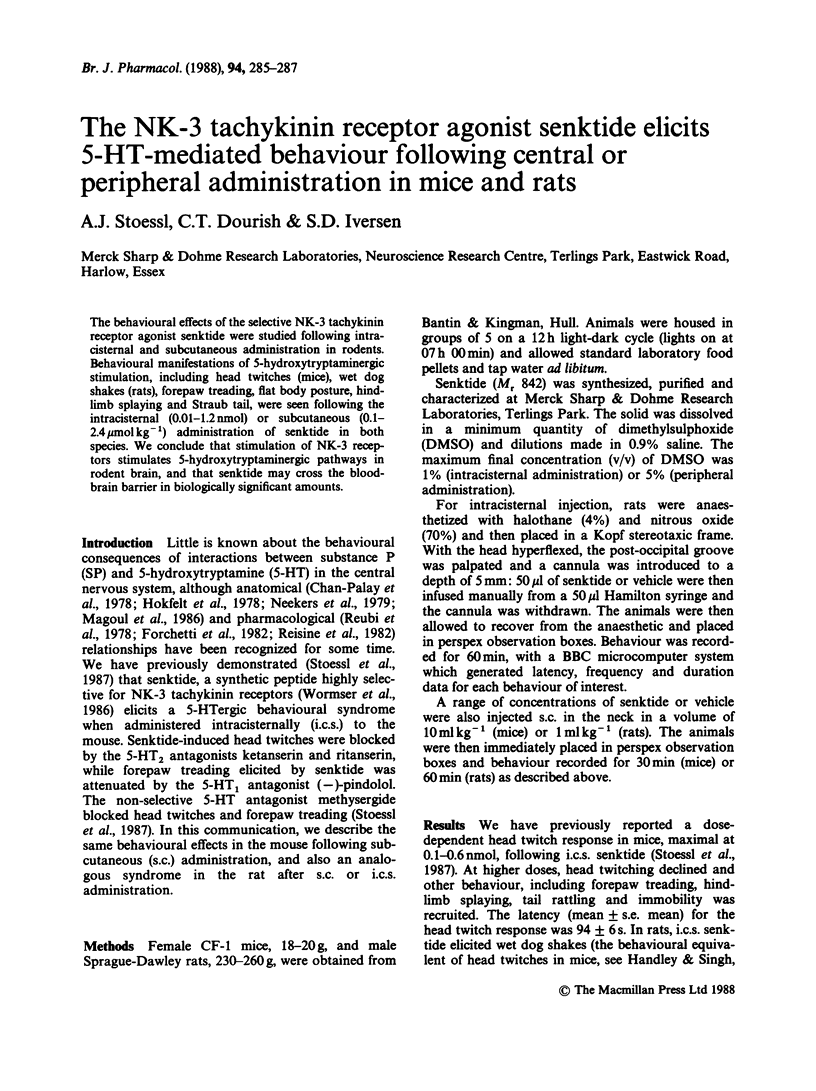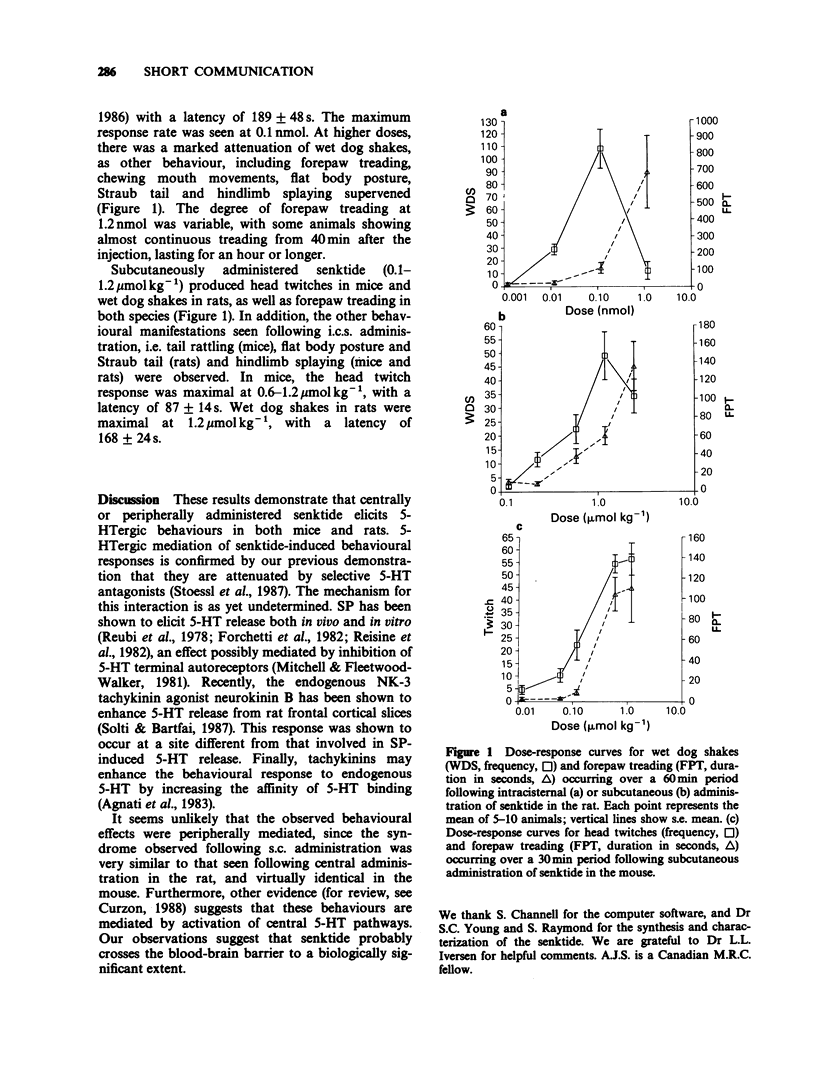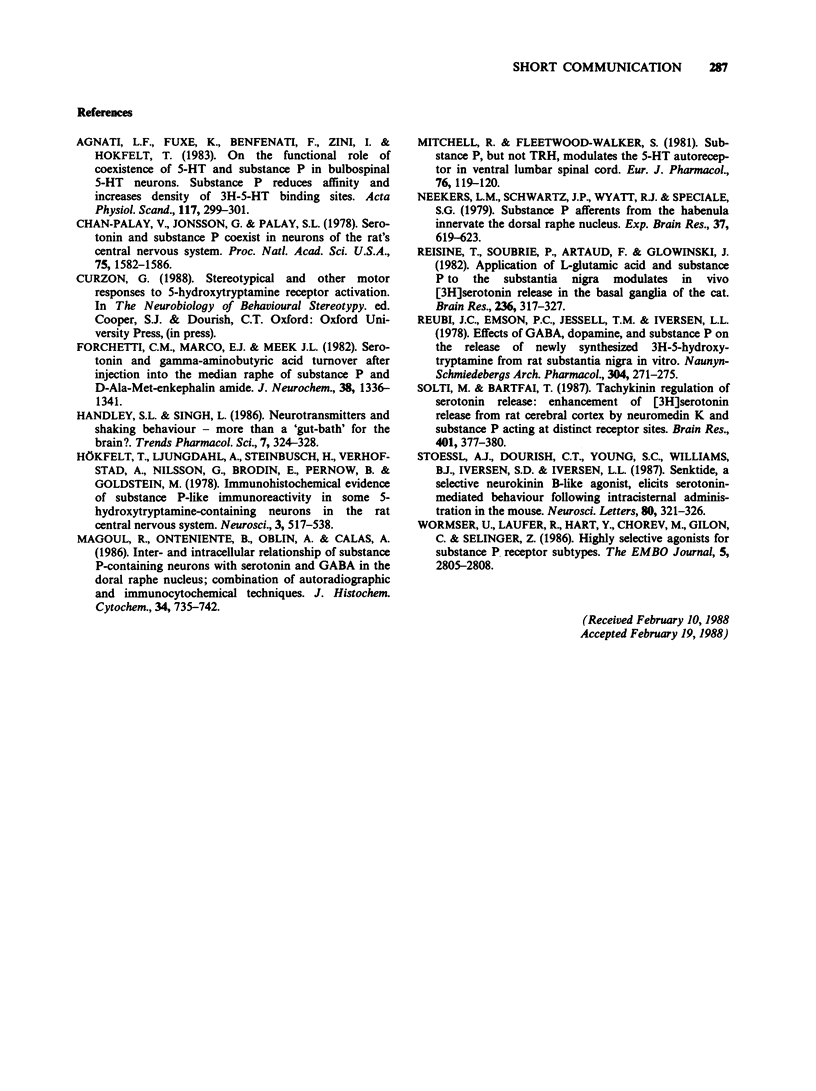Abstract
The behavioural effects of the selective NK-3 tachykinin receptor agonist senktide were studied following intracisternal and subcutaneous administration in rodents. Behavioural manifestations of 5-hydroxytryptaminergic stimulation, including head twitches (mice), wet dog shakes (rats), forepaw treading, flat body posture, hindlimb splaying and Straub tail, were seen following the intracisternal (0.01-1.2 nmol) or subcutaneous (0.1-2.4 mumol kg-1) administration of senktide in both species. We conclude that stimulation of NK-3 receptors stimulates 5-hydroxytryptaminergic pathways in rodent brain, and that senktide may cross the blood-brain barrier in biologically significant amounts.
Full text
PDF


Selected References
These references are in PubMed. This may not be the complete list of references from this article.
- Agnati L. F., Fuxe K., Benfenati F., Zini I., Hökfelt T. On the functional role of coexistence of 5-HT and substance P in bulbospinal 5-HT neurons. Substance P reduces affinity and increases density of 3H-5-HT binding sites. Acta Physiol Scand. 1983 Feb;117(2):299–301. doi: 10.1111/j.1748-1716.1983.tb07210.x. [DOI] [PubMed] [Google Scholar]
- Chan-Palay V., Jonsson G., Palay S. L. Serotonin and substance P coexist i, neurons of the rat's central nervous system. Proc Natl Acad Sci U S A. 1978 Mar;75(3):1582–1586. doi: 10.1073/pnas.75.3.1582. [DOI] [PMC free article] [PubMed] [Google Scholar]
- Forchetti C. M., Marco E. J., Meek J. L. Serotonin and gamma-aminobutyric acid turnover after injection into the median raphe of substance P and D-ala-met-enkephalin amide. J Neurochem. 1982 May;38(5):1336–1341. doi: 10.1111/j.1471-4159.1982.tb07910.x. [DOI] [PubMed] [Google Scholar]
- Hökfelt T., Ljungdahl A., Steinbusch H., Verhofstad A., Nilsson G., Brodin E., Pernow B., Goldstein M. Immunohistochemical evidence of substance P-like immunoreactivity in some 5-hydroxytryptamine-containing neurons in the rat central nervous system. Neuroscience. 1978;3(6):517–538. doi: 10.1016/0306-4522(78)90017-9. [DOI] [PubMed] [Google Scholar]
- Mitchell R., Fleetwood-Walker S. Substance P, but not TRH, modulates the 5-HT autoreceptor in ventral lumbar spinal cord. Eur J Pharmacol. 1981 Nov 19;76(1):119–120. doi: 10.1016/0014-2999(81)90020-0. [DOI] [PubMed] [Google Scholar]
- Mâgoul R., Onteniente B., Oblin A., Calas A. Inter- and intracellular relationship of substance P-containing neurons with serotonin and GABA in the dorsal raphe nucleus: combination of autoradiographic and immunocytochemical techniques. J Histochem Cytochem. 1986 Jun;34(6):735–742. doi: 10.1177/34.6.2422252. [DOI] [PubMed] [Google Scholar]
- Neckers L. M., Schwartz J. P., Wyatt R. J., Speciale S. G. Substance P afferents from the habenula innervate the dorsal raphe nucleus. Exp Brain Res. 1979;37(3):619–623. doi: 10.1007/BF00236830. [DOI] [PubMed] [Google Scholar]
- Reisine T., Soubrie P., Artaud F., Glowinski J. Application of L-glutamic acid and substance P to the substantia nigra modulates in vivo [3H]serotonin release in the basal ganglia of the cat. Brain Res. 1982 Mar 25;236(2):317–327. doi: 10.1016/0006-8993(82)90717-x. [DOI] [PubMed] [Google Scholar]
- Reubi J. C., Emson P. C., Jessell T. M., Iversen L. L. Effects of GABA, dopamine, and substance P on the release of newly synthesized 3H-5-hydroxytryptamine from rat substantia nigra in vitro. Naunyn Schmiedebergs Arch Pharmacol. 1978 Oct;304(3):271–275. doi: 10.1007/BF00507968. [DOI] [PubMed] [Google Scholar]
- Solti M., Bartfai T. Tachykinin regulation of serotonin release: enhancement of [3H]serotonin release from rat cerebral cortex by neuromedin K and substance P acting at distinct receptor sites. Brain Res. 1987 Jan 20;401(2):377–380. doi: 10.1016/0006-8993(87)91424-7. [DOI] [PubMed] [Google Scholar]
- Stoessl A. J., Dourish C. T., Young S. C., Williams B. J., Iversen S. D., Iversen L. L. Senktide, a selective neurokinin B-like agonist, elicits serotonin-mediated behaviour following intracisternal administration in the mouse. Neurosci Lett. 1987 Oct 5;80(3):321–326. doi: 10.1016/0304-3940(87)90475-7. [DOI] [PubMed] [Google Scholar]
- Wormser U., Laufer R., Hart Y., Chorev M., Gilon C., Selinger Z. Highly selective agonists for substance P receptor subtypes. EMBO J. 1986 Nov;5(11):2805–2808. doi: 10.1002/j.1460-2075.1986.tb04571.x. [DOI] [PMC free article] [PubMed] [Google Scholar]


